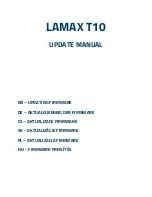
PicSight GigE Getting Started Guide, version 1.96.169.1
27
In the
Pulse Width Controlled Mode
the shutter time is determined by the
width of the trigger pulse. As is explained in the chapter
The Trigger Inputs
, only
the TTL trigger input can be used for this mode; when the opto-input is used for
trigger, it behaves like in the
Edge Preselect Mode
.
I/O Settings
By pressing the
Input/Output Settings
button the
I/O Settings Dialog
can be
displayed.
Here you can select the trigger input. Note that the dialog is designed to be
more universal (also for frame grabbers), so not all options apply to PicSight
GigE. In the
Function
combo box select
Frame Trigger
, in the
Type
select
Direct
.
Then you can select the trigger input:
After pressing the
Opto
button you can select between
Opto In 0
and
Opto In 1
.
Or after pressing the
TTL
button you can select the TTL input - although there
are internally 6 TTL inputs available, only one is available on the Hirose
connector in the standard HW configuration. This one is marked in the list as
Gpio In 5 (Trg-In)
. Note that the polarity on the TTL input cannot be configured
- the pulse must always be positive (see
The Trigger Inputs
chapter for details).
You can also select the
Signal Edge
(
High
= raising edge,
Low
= falling edge).
Sequence of Images
The received images can be stored in a
circular buffer
. In the
Images in a
sequence
field you can set the number of images in the buffer. You can browse
the images in the sequence using the controls in the
Display
tab.
Initializing
When the configuration is complete, press the
Initialize
button.
4.5.2.
Run-time Settings
After successful initialization, during the run-time you can set the
gain
and the
shutter time
in the
Run-time Settings
tab.





































